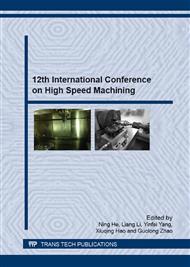[1]
F.W. Taylor, On the art of cutting metals. Transactions of ASME, 28 (1907) 31–248404.
Google Scholar
[2]
S.A. Tobias, Machine Tool Vibration, Blackie and Sons Ltd. (1965).
Google Scholar
[3]
J. Tlusty, Manufacturing processes and equipment, Prentice Hall, Upper Saddle River, New Jersey, USA, (2000).
Google Scholar
[4]
R. Sridhar, R.E. Hohn and G.W. Long, A Stability Algorithm for the General Milling Process, ASME Journal of Engineering for Industry, 1968, pp.330-334.
DOI: 10.1115/1.3604637
Google Scholar
[5]
M. Subramanian, M. Sakthivel, K. Sooryaprakash and R. Sudhakaran, Optimizatin of end mill tool geometry parameters for Al7075-T6 machining operations based on vibration amplitude by response surface methodology, Measurement, 46 (2013) 10.
DOI: 10.1016/j.measurement.2013.08.015
Google Scholar
[6]
S. Smith and J. Tlusty, Current trends in high-speed machining, Journal of Manufacturing Science and Engineering, 119 (1997) 664–666.
DOI: 10.1115/1.2836806
Google Scholar
[7]
E. Budak, L.T. Tunc, A new method for identification and modeling of process damping in machining, Journal of Manufacturing Science and Engineering, 131 (2009) 1-10.
DOI: 10.1115/1.4000170
Google Scholar
[8]
H. Schulz, T. Moriwaki, High-speed machining, Ann. of the CIRP, 41 (1992) 637-642.
Google Scholar
[9]
S. Smith, and J. Tlusty, An overview of Modeling and Simulation of the Milling process, Trans. ASME Journal of Engineering for Industry, 113 (1991) 169-175.
DOI: 10.1115/1.2899674
Google Scholar
[10]
R. Sridhar, R.E. Hohn and G.W. Long, General Formulation of the Milling Process Equation, ASME Journal of Engineering for Industry, a (1968) 317-324.
DOI: 10.1115/1.3604635
Google Scholar
[11]
S. Smith and J. Tlusty, Update on high-speed milling dynamics, Journal of Engineering for Industry-Transactions of the Asme, 112 (1990) 142-149.
DOI: 10.1115/1.2899557
Google Scholar
[12]
M.L. Campomanes and Y. Altintas, An improved time domain simulation for dynamic milling at small radial immersions, Journal of Manufacturing Science and Engineering-Transactions of the Asme, 125 (2003) 416-422.
DOI: 10.1115/1.1580852
Google Scholar
[13]
J. Tlusty and P. Macneil, Dynamics of cutting forces in end milling, Annals of the CIRP, 24 (1975) 21-25.
Google Scholar
[14]
A. Larue, and Y. Altintas, Simulation of flank milling processes, International Journal of Machine Tools & Manufacture, 45 (2005) 549-559.
DOI: 10.1016/j.ijmachtools.2004.08.020
Google Scholar
[15]
Die & Mould Making Application Guide, Sandvik Coromant, (1999).
Google Scholar


